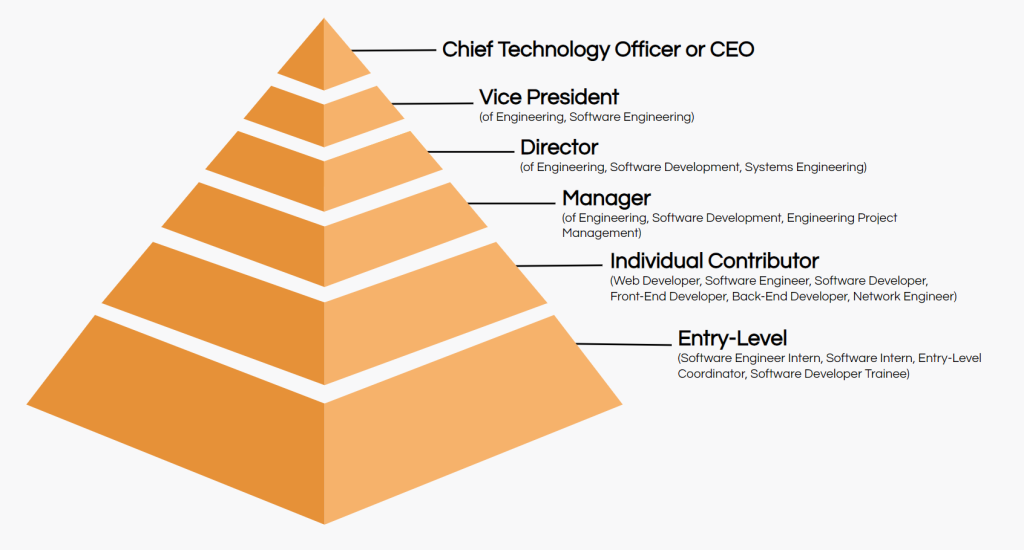Mastering The Software Development Hierarchy: Unlock Your Coding Potential Now!
Software Development Hierarchy: Understanding the Structure and Roles
Introduction
Hello Readers,
Welcome to this informative article on software development hierarchy. In today’s fast-paced digital world, software development plays a crucial role in various industries. Understanding the hierarchy within this field is essential for both professionals and aspiring developers. In this article, we will delve into the details of software development hierarchy, its components, and the roles each level plays in the development process.
1 Picture Gallery: Mastering The Software Development Hierarchy: Unlock Your Coding Potential Now!

So, let’s dive in and explore the fascinating world of software development hierarchy!
What is Software Development Hierarchy?
🔑 Software development hierarchy refers to the organizational structure and roles within a software development team. It outlines the various levels, responsibilities, and interactions within the team, ensuring a smooth workflow and efficient development process.
At its core, software development hierarchy provides a clear framework for collaboration and decision-making, allowing teams to divide tasks, allocate resources, and manage complex projects effectively.
Key Roles in Software Development Hierarchy

Image Source: cloudfront.net
👩💻👨💻 Software development hierarchy encompasses several key roles, each with distinct responsibilities and expertise. Let’s take a closer look at some of the essential roles within this hierarchy:
1. Software Developer: This role involves writing, testing, and maintaining software code. Developers are responsible for translating requirements into functional applications and ensuring the codebase is efficient and scalable.
2. Project Manager: Project managers oversee the entire software development process, ensuring that projects are completed within the allocated time, budget, and scope. They coordinate team efforts, manage resources, and ensure effective communication between stakeholders.
3. Quality Assurance Engineer: QA engineers focus on testing software applications to identify and eliminate bugs and issues. They develop test plans, execute test cases, and ensure that the final product meets the required quality standards.
4. System Analyst: System analysts bridge the gap between business requirements and technical implementation. They gather and analyze user needs, design system solutions, and communicate requirements to the development team.
5. Technical Architect: Technical architects design the overall structure and framework of software applications. They make high-level design decisions, ensure system scalability and performance, and guide the development team in implementing best practices.
These are just a few examples of the roles involved in software development hierarchy. The specific roles within a team may vary depending on the organization and project requirements.
Who Can Benefit from Software Development Hierarchy?
🌟 Software development hierarchy is beneficial for various individuals and entities involved in the software development process. Here are some examples:
1. Developers and Engineers: Understanding the hierarchy helps developers navigate their career paths, set goals, and identify areas for growth. It provides a roadmap for skill development and advancement within the field.
2. Project Stakeholders: For stakeholders, such as clients or business owners, understanding the hierarchy ensures effective communication and collaboration with the development team. It helps them align their expectations and requirements with the capabilities of the team.
3. Managers and Team Leads: Software development hierarchy guides managers in organizing and leading their teams effectively. It helps them assign tasks, delegate responsibilities, and create a conducive work environment.
By understanding the software development hierarchy, individuals and entities can optimize their involvement, improve collaboration, and enhance the overall development process.
When Should You Consider Software Development Hierarchy?
⏰ Software development hierarchy is essential for both established organizations and aspiring developers. Here are some scenarios where considering the hierarchy becomes crucial:
1. Scaling a Development Team: As an organization grows, it becomes necessary to establish a clear hierarchy to streamline the development process. This ensures efficient resource allocation and effective coordination between team members.
2. Career Development: For aspiring developers, understanding the hierarchy helps in setting career goals and identifying the necessary skills and experience required to progress within the field.
3. Project Planning: When undertaking complex software development projects, having a well-defined hierarchy allows for better project planning and management. It helps in assigning tasks, estimating timelines, and mitigating risks.
Whether you are a seasoned professional or just starting your journey in software development, considering the hierarchy can greatly benefit your career and project outcomes.
Where Does Software Development Hierarchy Apply?
🌍 Software development hierarchy is applicable across various industries and organizations that rely on software development for their operations. Some common domains where the hierarchy is prevalent include:
1. Information Technology: IT companies often have dedicated software development teams structured according to the hierarchy. This ensures efficient software delivery and maintenance.
2. Financial Services: Banks, insurance companies, and other financial institutions heavily rely on software development for their operations. The hierarchy helps them manage complex projects and ensure compliance with regulations.
3. Healthcare: The healthcare industry utilizes software development for electronic medical records, patient management systems, and other critical applications. The hierarchy ensures the development of secure and reliable software solutions.
These are just a few examples, but software development hierarchy is applicable in almost any industry where software is developed to support business processes.
Why Is Software Development Hierarchy Important?
❗ Software development hierarchy is vital for several reasons. Let’s explore why it holds such significance within the field:
1. Efficient Collaboration: The hierarchy provides a structured framework for effective collaboration between team members. It ensures clear communication channels, reduces duplication of efforts, and enhances overall productivity.
2. Resource Allocation: With a clear hierarchy, managers can allocate resources, such as developers and testers, based on their expertise and project requirements. This optimizes resource utilization and prevents bottlenecks.
3. Career Growth: For developers, the hierarchy offers a clear career path with defined roles and responsibilities. It allows them to set goals, acquire new skills, and progress within the field.
4. Risk Management: The hierarchy facilitates risk management by assigning specific roles for quality assurance and testing. This ensures that potential issues are identified and resolved early in the development process.
By recognizing the importance of software development hierarchy, organizations and individuals can streamline their processes, improve collaboration, and achieve better outcomes.
How Does Software Development Hierarchy Work?
🔧 Software development hierarchy operates through clear levels of authority and responsibility. Here is a general overview of how it works:
1. Project Initiation: The project manager and system analyst work together to identify project requirements, goals, and constraints. They collaborate with stakeholders to define the scope and ensure alignment with organizational objectives.
2. Planning and Design: The technical architect, in collaboration with the development team, designs the overall system architecture. They break down the project into manageable tasks and assign responsibilities to the team members.
3. Development and Testing: Developers write the code based on the design specifications provided by the technical architect. Quality assurance engineers perform rigorous testing to identify and fix any bugs or issues.
4. Deployment and Maintenance: Once the software is deemed ready, it is deployed to the production environment. The maintenance team monitors the software, provides updates and patches, and ensures its continued functionality.
Throughout this process, effective communication and collaboration among team members are crucial. The hierarchy provides a clear structure for individuals to work together towards a common goal.
Advantages and Disadvantages of Software Development Hierarchy
👍👎 Like any organizational structure, software development hierarchy has its pros and cons. Let’s explore some of them:
Advantages:
1. Clear Roles and Responsibilities: The hierarchy ensures that each team member has defined roles and responsibilities, minimizing confusion and promoting accountability.
2. Efficient Resource Management: With a clear hierarchy, managers can allocate resources effectively, matching the right individuals to specific tasks, and optimizing productivity.
3. Streamlined Decision-Making: The hierarchy provides a framework for decision-making, allowing for faster and more efficient resolution of issues and conflicts.
Disadvantages:
1. Lack of Flexibility: The hierarchy may limit spontaneity and hinder creativity within the development process. It can be rigid and slow to adapt to evolving project needs.
2. Communication Barriers: The hierarchy may create communication gaps between different levels, leading to misunderstandings and delays in project delivery.
3. Overemphasis on Roles: In some cases, the hierarchy may result in individuals focusing solely on their assigned roles, limiting cross-functional collaboration and innovation.
It is essential to weigh these advantages and disadvantages based on the specific organization and project requirements before adopting a software development hierarchy.
Frequently Asked Questions (FAQ)
1. Q: Can the software development hierarchy be customized to fit specific project needs?
A: Yes, organizations can modify the hierarchy to align with their unique project requirements and team dynamics. It is essential to strike a balance between structure and flexibility.
2. Q: Is software development hierarchy only applicable to large-scale projects?
A: No, software development hierarchy can be beneficial for projects of all sizes. It provides clarity, ensures effective resource management, and promotes collaboration.
3. Q: How does software development hierarchy impact career growth?
A: Software development hierarchy offers a clear career path with defined roles and responsibilities. It helps developers set goals, acquire new skills, and advance within the industry.
4. Q: Can multiple roles be assigned to a single individual in the software development hierarchy?
A: Yes, in smaller teams or organizations, individuals may take on multiple roles within the hierarchy. However, it is important to ensure that workload and responsibilities are manageable.
5. Q: Does every software development team follow the same hierarchy structure?
A: No, the specific hierarchy structure may vary between organizations and teams. Factors such as project complexity, company size, and industry requirements influence the hierarchy’s configuration.
Conclusion
In conclusion, software development hierarchy plays a crucial role in organizing and managing software development teams. It provides a clear structure for collaboration, resource management, and effective decision-making. By understanding the roles and responsibilities within the hierarchy, professionals can navigate their careers, and organizations can optimize their development processes.
So, whether you are a developer, a project stakeholder, or a manager, embracing the software development hierarchy can lead to enhanced productivity, improved outcomes, and a successful software development journey.
Final Remarks
📝 In this article, we have explored the concept of software development hierarchy, its importance, and its impact on the development process. By understanding the roles and responsibilities within the hierarchy, individuals can make informed decisions and contribute effectively to their teams.
However, it is crucial to remember that the hierarchy is not a rigid structure set in stone. It should be adaptable to the organization’s needs and encourage open communication and collaboration. Embracing a flexible and inclusive hierarchy can foster innovation and drive success in software development projects.
Thank you for joining us on this insightful journey into the world of software development hierarchy. We hope you found this article valuable and informative.
Happy developing!
This post topic: Programming


